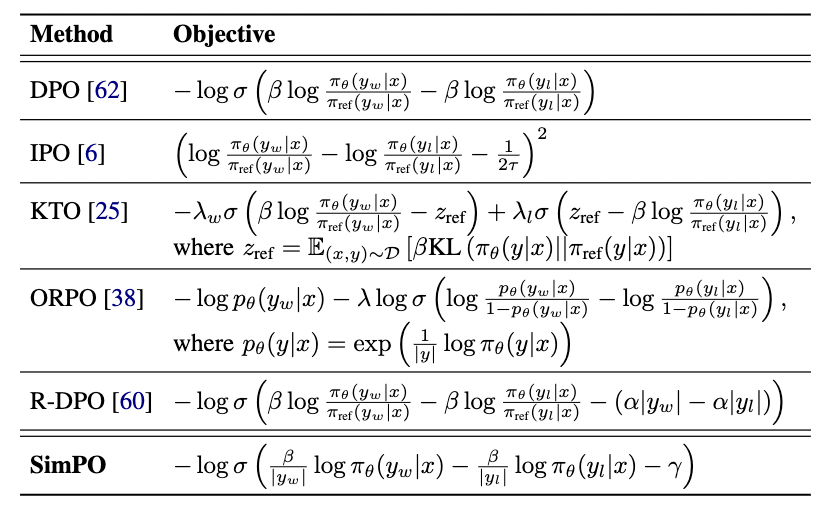SimPO: Simple Preference Optimization with a Reference-Free Reward
For background about DPO, readers are kindly referred to TDPO.
Drawbacks of DPO:
- need a reference model
- the reward formulation is not directly aligned with the metric used to guide generation
In response, this work propose SimPO, a simple yet effective offline preference optimization algorithm. The core of the algorithm aligns the reward function in the preference optimization objective with the generation metric. SimPO consists of two major components:
- a length-normalized reward, calculated as the average log probability of all tokens in a response using the policy model.
- a target reward margin to ensure the reward difference between winning and losing responses exceeds this margin.
Adopting the reward function defined in DPO as the following drawbacks:
- the requirement of a reference model \(\pi_{\rm ref}\) during training incurs additional memory and computational costs.
- there is a discrepancy between the reward being optimized during training and the generation metric used for inference
During generation, the policy model \(\pi_\theta\) is used to generate a sequence that approximately maximizes the average log likelihood, defined as follows:
\[p_\theta(y|x)=\frac{1}{\|y\|}\log\pi_\theta(y|x)=\frac{1}{\|y\|}\sum_{i=1}^{\|y\|}\log\pi_\theta(y_i\|x,y_{<i}).\]While direct maximization of this metric during decoding is intractable, in DPO, for any triple \((x,y_w,y_l)\), satisfying the reward ranking \(r(x,y_w) > r(x,y_l)\) does not necessarily mean that the likelihood ranking \(p_\theta(y_w\|x) > p_\theta(y_l\|x)\) is met. It is natural to replace the reward function in DPO with \(p_\theta\) since it aligns with the likelihood metric that guides generation, resulting in a length-normalized reward:
\[r_{\rm SimPO}(x,y)=\beta\cdot p_\theta(y|x),\]where \(\beta\) is a constant that controls the scaling of the reward difference.
Additionally, they introduce a target reward margin term \(\gamma>0\), to the Bradley-Terry objective to ensure that the reward for the winning response \(r(x,y_w)\), exceeds the reward for the losing response \(r(x,y_l)\) by at least \(\gamma\):
\[p(y_w\succ y_l\|x)=\sigma(r(x,y_w)-r(x,y_l)-\gamma).\]Hence, we can derive the objective function of SimPO by NLL loss:
\[L_{\rm SimPO}(\pi\_\theta)=-\mathbb{E}_{(x,y_w,y_l)\sim\mathcal{D}}[\log\sigma(p(y_w\succ y_l\|x))].\]The comparison of objective functions between SimPO and other baselines is put in the table below:
